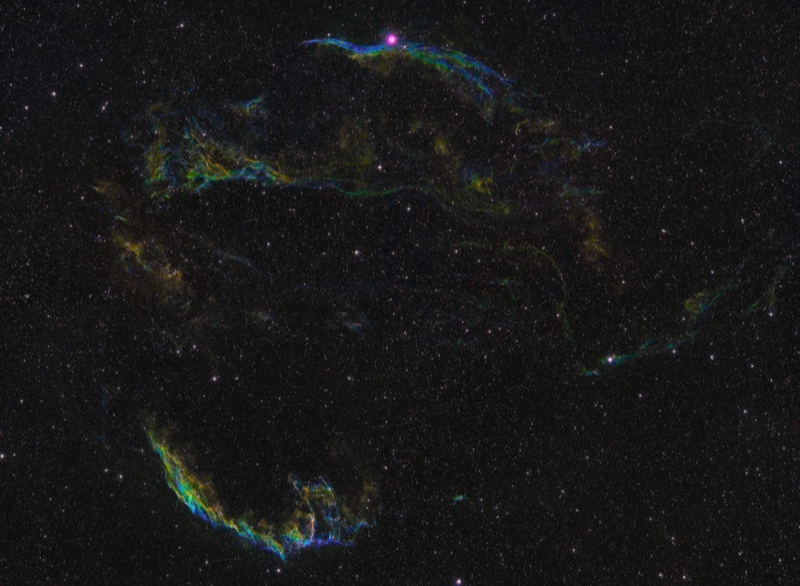
NGC 6960, NGC 6992 (The Veil Nebula)
Alternative Nomenclature: NGC 6995, NGC 6974, IC 1340, Cygnus Loop, Cirrus Nebula, Filamentary Nebula, Witch’s Broom Nebula (NGC 6960), Caldwell 33, Caldwell 34, Pickering’s Triangle
Constellation: Cygnus
Right Ascension: 20h 45m 8.23s
Declination: +30deg 42min 30s
Magnitude: 7.5
News flash: The Veil Nebula is a cosmic duet! It can be seen with 15×70 binoculars under a dark sky.
Yes, the Veil Nebula is the remnant of a supernova, but parts of the Veil Nebula have been assigned different NGC catalog numbers. Therefore, in my book it qualifies as a cosmic duet!
The nebula was discovered on September 5, 1784, by William Herschel. He described in his observational notes the western end of the nebula as:“Extended; passes thro’ 52 Cygni… near 2 degree in length.”
Herschel described the eastern end of the Veil Nebula as: “Branching nebulosity… The following part divides into several streams uniting again towards the south.”
The Veil Nebula is a supernova remnant of heated and ionized gas and dust located some 1,470 light years from Earth. The progenitor star exploded somewhere between 5,000 to 8,000 years ago, and the remnants have since expanded to cover an area in the visual range of roughly 3 degrees in diameter. The Veil Nebula is visually about 6 times the diameter, or 36 times the area, of the full Moon.
To view the Veil Nebula, a combination of a dark, moonless night away from city lights and the technology of an O-III filter will be needed. Remember, the Veil Nebula is large, and is made up of several parts. As can be seen in the many names and nomenclatures for the Veil, the observer will be observing all the separate components that make up the Veil when using binoculars.
There are three main visual components, plus faint patches:
The Western Veil (Caldwell 34), consisting of NGC 6960 (the “Witch’s Broom” or Filamentary Nebula
The Eastern Veil (Caldwell 33), whose brightest area is NGC 6992, trailing off farther south into NGC 6995 and IC 1340
Pickering’s Triangle, brightest at the north central edge of the loop, but visible in photographs continuing toward the central area of the loop.
NGC 6974 and NGC 6979 are faint patches of nebulosity on the northern rim between NGC 6992 and Pickering’s Triangle.
The Veil Nebula is a favorite target among amateur astronomers, for the beauty and delicacy of its components. A very dark night at a dark site is needed. With a wide-angle 10×50 or 12×60 binoculars and the help of O-III filters, all the nebula elements will be visible. The O-III filter works the best, since virtually all the visible light from the Veil Nebula is due to doubly ionized oxygen. Remember, binoculars requires two eyes, thus two OIII filters. It can get expensive.
The size of the Veil Nebula is impressively huge, measuring 3.5 degrees by 2.7 degrees.
As an alternative, a modern 102-mm short focus (f/5 – f/7) refractor and a low power ultra wide field eyepiece can encompass a large portion of the Veil at one time. A 2” wide field, 82° or wider, focal length 30mm to 40mm eyepiece is applicable here. In this case, you can get away with one 2” OIII filter.
As previously mentioned, the Veil Nebula is the remains of a star that went supernova and exploded approximately 5,000 to 8,000 years ago.The star that left these scattered remains was once much larger than our own Sun. Instead of dying out to a white dwarf, as do stars the size the Sun, large stars die the violent death of a supernova. The explosion swept out a huge bubble in its surroundings, heating up gas and dust, and the remnants are visible in telescopes.
It’s likely that the progenitor star that exploded creating the Veil Nebula was a spectacular sight to humans on Earth 10,000 years ago. Unfortunately, no archeological evidence has been found documenting the human reaction to this supernova.